Do you bear in mind Present and Inform occasions while you have been in elementary faculty? Greater than seemingly you introduced a particular object to high school and confirmed your classmates the way it labored or what was distinctive about it. Possibly you defined a little bit of historical past about your explicit merchandise or why it was necessary to you.
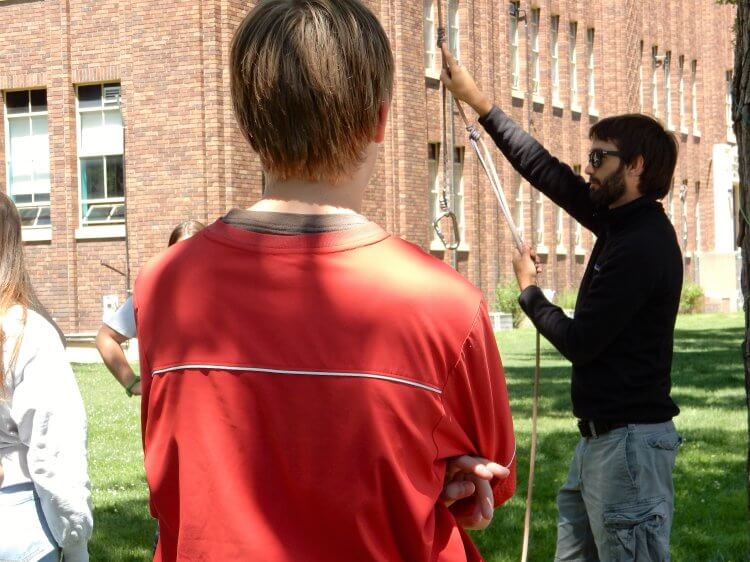
From an academic standpoint, the aim of Present and Inform was to assist youngsters developed their public talking abilities. The idea of Present and Inform will be even be utilized to educating and training when utilizing demonstrations throughout a lesson or observe. There was a wealth of motor studying analysis over time on the use and worth of demonstrations (present) and verbal directions (inform) to facilitate studying a brand new job (Magill and Anderson, 2017; Schmidt and Lee, 2014; SHAPE America 2014; Wulf, 2013). When embracing the Social Studying Idea framework, demonstrating a talent or job creates a psychological picture that college students can establish with as they try to breed the motion or exercise (Magill & Anderson, 2017). The idea, “an image is value a thousand phrases,” emphasizes the significance of demonstrating talent methods and actions when educating and training. Including verbal instruction, together with an illustration, additional helps college students assimilate the duty being taught.
It has been my expertise that trainer preparation candidates discover it a lot simpler to make use of verbal explanations than demonstrations throughout instruction. The truth is, they’re actually good at telling. College students in trainer/coach preparation applications typically have acquired a excessive degree of content material data, particularly in these sports activities or actions they’ve performed. As such, they have an inclination to elucidate every thing they know when educating a talent. The overload of data supplied turns into an excessive amount of for learners to successfully course of and bear in mind. Plus, extreme speaking in the course of the clarification takes up an excessive amount of time inside a lesson or observe and reduces the period of time obtainable for observe and play alternatives.
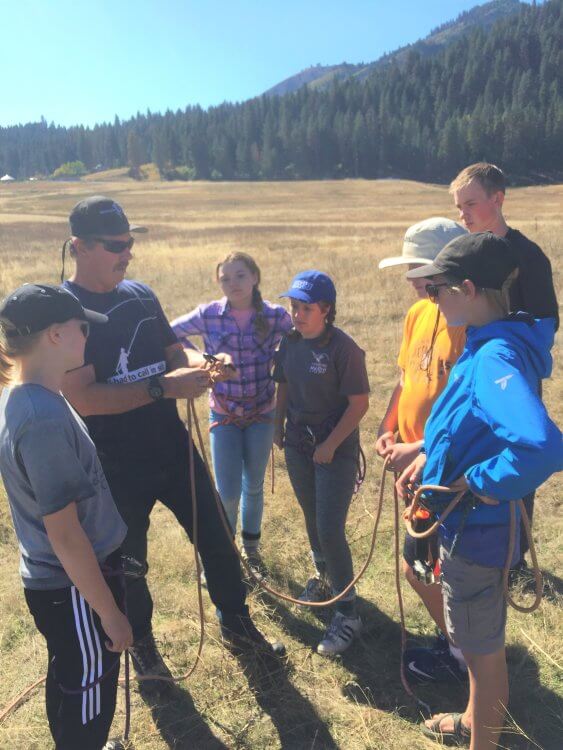
One of many methods to curb data overload is to maintain the demonstration and clarification easy by specializing in one or two elements of a talent at a time (Magill and Anderson, 2017; SHAPE America, 2014). How do you identify what movement or talent components are most necessary to show as a part of an illustration? One technique is to taper the quantity of content material by utilizing a funnel method (Shimon, 2020). When utilizing the funnel format, the most important opening of the funnel accommodates a complete record of all of the elements of a talent (talent components) which are wanted to carry out the talent (eg, bend the knees; unfold toes aside; snap the wrist; push off the toes). In figuring out the talent components, contemplate what college students have to do when making ready to carry out the talent, executing the talent, and ending the talent motion. Because the funnel narrows, the inclusive record discovered on the high of the funnel is condensed by choosing 5 or 6 most necessary talent components. Typically a number of separate talent components will be mixed into one movement. For instance, when a trainer or coach says, “begin in an athletic stance, college students know to bend their knees, unfold their toes shoulder-width aside, and get their palms out in entrance of their physique. By utilizing the cue “begin in an athletic stance,” the variety of separate talent components to exhibit and clarify has been lowered to 1 factor. On the narrowest a part of the funnel, just one or two of essentially the most crucial talent components are chosen from the condensed record. These allotted talent components grow to be the focus in the course of the preliminary demonstration, which is able to assist lower down the quantity of data delivered at one time. Have in mind, narrowing the record of necessary talent elements will range, relying on the talent ranges of scholars.
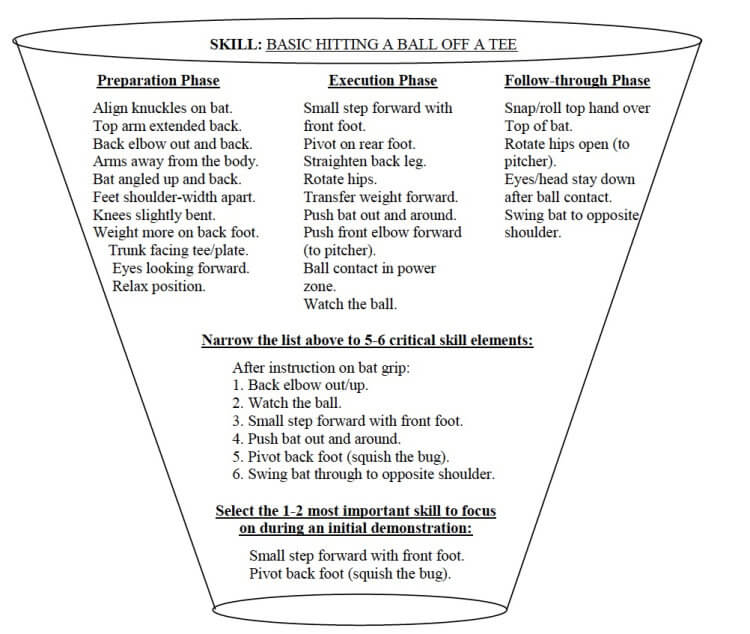
As seen in Determine 1, a complete record of talent components for hitting a ball off a tee has been decided by a trainer. That is plenty of data to elucidate and exhibit, so the trainer narrowed the record to incorporate six most necessary talent components her college students have to know. Lastly, the trainer chosen two talent components from the refined record of six to deal with first whereas demonstrating your entire swing: (a) the brief step ahead with the entrance foot, and (b) the again foot pivot (squish the bug) in the course of the swing. Different talent components from the trainer’s condensed record might be demonstrated and defined later as college students observe and refine their swing method.
As a talent is being demonstrated, it is very important draw college students’ consideration to 1 or two talent elements to watch. This method is known as attentional focus (Wulf, 2013) and helps diminish different much less related facets of the talent pupil could observe throughout an illustration. The usage of a video mannequin may also be an efficient approach to exhibit a talent (Lhuisset & Margenes, 2015). Relying on the video, a trainer or coach might have to use the idea of attentional focus by stating one or two focus talent areas for college kids to observe. Utilizing a video mannequin permits the teacher to additionally gradual the pace of the motion and replay sure elements of the talent a number of instances in a row.
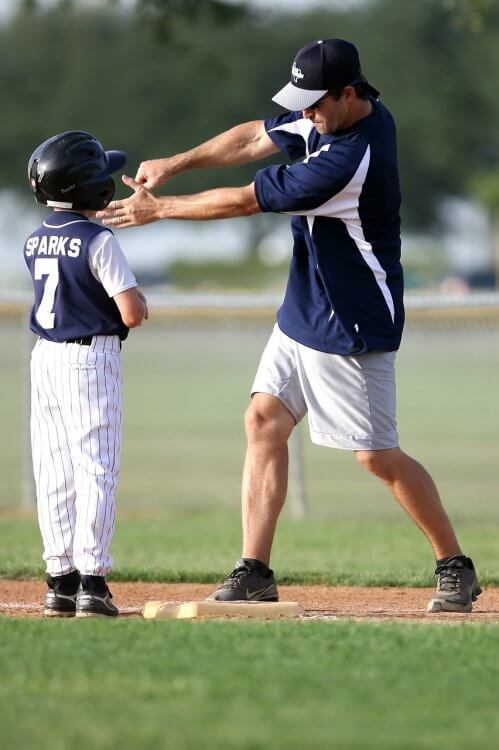
When demonstrating a motion or talent, utilizing educating cues is a significant approach to make clear a movement or motion of the motion. Instructing cues are sometimes easy phrases or acquainted phrases college students can bear in mind, and academics can confer with these cues when offering suggestions as college students observe (Fronske and Well being, 2015). For instance, attain into the cookie jar is a typical cue used when describing the follow-through movement of a set shot in basketball. Squish the bug was a educating cue present in Determine 1 to characterize the back-foot pivot when hitting a ball off a tee.
Permitting ample alternatives for talent repetition and observe compliments the worth of the demonstration. Constant suggestions, utilizing attentional focus cues, reinforces the demonstration. Instructing cues will be enhanced by contemplating inner or exterior attentional focus cues (Wulf, 2013). Inner focus cues embody the best way the physique strikes. For instance, a trainer could say, “lengthen your arm” to encourage a pupil to get extra top when executing a set shot. Alternatively, exterior cues focus consideration on an object or the surroundings as a part of the movement. Attain for the rim is an exterior focus cue a trainer could use as an alternative of the inner cue, lengthen your arm. Normally utilizing cues with an exterior focus will assist college students higher their efficiency, for his or her consideration might be on performing the general motion, versus concentrating on a single physique half (Magill and Anderson, 2017; Wulf, 2013). It might be useful to make use of each inner and exterior focus cues to see what works finest with the scholars you educate or coach.
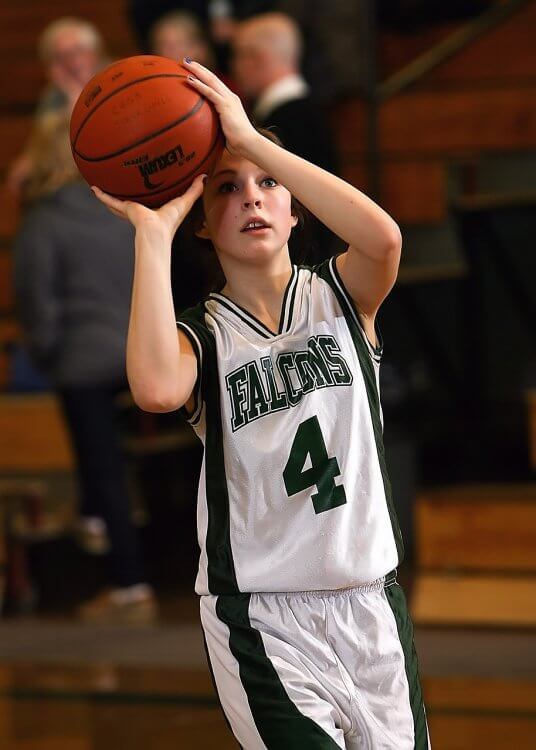
Demonstrations are usually not solely efficient when demonstrating a talent; they are often equally helpful when incorporating drills and actions right into a lesson or observe. Lecturers and coaches typically assume that college students perceive how one can execute varied drills and video games, in order that they solely clarify how one can do the duty. When, actually, many college students could not perceive the reason. It’s useful and environment friendly to make use of pupil volunteers when demonstrating and explaining a job, whether or not the duty is with a associate or in small teams. The remainder of the group is ready to watch and hear how the duty is carried out, thus minimizing confusion when college students are despatched off to observe. If the demonstration isn’t carried out accurately, do not fret. College students additionally study once they hear the trainer or coach make corrections and observe enhancements being made by the group in the course of the demonstration (Hebert, 2018; Magill and Anderson, 2017).
Lastly, how are you aware in case your present and inform was efficient? In different phrases, are you assured college students know what to do? Earlier than college students observe a talent or job, implement a fast check-for-understanding technique. One approach to verify for understanding is to have college students present you the movement you might be asking them to carry out throughout or instantly after an illustration. For instance, you would have college students present you their forehand volleyball grip or the taking pictures movement of a set shot earlier than they observe the talent. One other easy check-for-understanding technique is to ask a particular query for college kids to reply. Centered questions may relate to sure motion cues college students are requested to observe, the variety of repetitions to carry out, or the actions of group members throughout a drill as examples.

General, the idea of present and inform go collectively like peas in a pod or peanut butter and jelly! Utilizing one with out the opposite isn’t as efficient as when utilizing each collectively. Whenever you inform it, additionally present it; deal with one or two particular talent components at a time; use educating cues to assist make clear a motion; and, bear in mind to verify for understanding. The usage of efficient demonstrations throughout a lesson or observe session is a useful tutorial device for academics and coaches.
This text was initially revealed on March 10, 2020.
References
Herbert, E. (2018). The consequences of observing a studying mannequin (or two) on motor talent acquisition. Journal of Motor Studying and Growth, 6: 4-17
Lhuuisset, L. and Margnes, E. (2015). The affect of dwell – vs. video-model presentation on the early acquisition of a brand new advanced coordination. Bodily Training and Sport Pedagogy, 20(5): 490-502.
Magill, RA and Anderson, D. (2017). Motor studying and management—Ideas and purposes, tenth ed. New York: McGraw-Hill.
Schmidt, RA and Lee, TD (2014). Motor studying and efficiency – From rules to utility, 5th ed. Champaign, IL: Human Kinetics.
SHAPE America. (2014). Nationwide requirements & grade-level outcomes for k-12 bodily training. Society of Well being and Bodily Educators. Champaign IL: Human Kinetics.
Shimon, J. (2020). Introduction to educating bodily training: Rules and techniques2nd ed. Champaign, IL: Human Kinetics. Wulf, G. (2013). Attentional focus and motor studying: A overview of 15 years. Worldwide Overview of Sports activities and Train Physiology, 6(1): 77-104.
